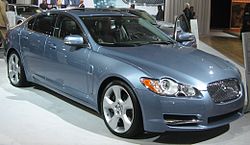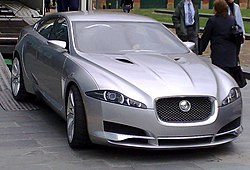Jaguar XF (X250)
| Jaguar XF | |
|---|---|
 | |
| Overview | |
| Manufacturer | Jaguar Cars |
| Production | 2008 - |
| Assembly | Castle Bromwich, England |
| Body and chassis | |
| Class | Mid-size luxury car / sports sedan |
| Body style | 4-door sedan |
| Layout | FR layout |
| Platform | Ford DEW98 platform |
| Powertrain | |
| Engine | 3.0L 240 hp AJ30 V6 4.2L 300 hp AJ34 V8 4.2L S/C 420 hp AJ34S V8 5.0 V8 XF-R 2.7L V6 Diesel AJD "Lion" V6 |
| Transmission | 6-speed automatic |
| Dimensions | |
| Wheelbase | Template:Auto in |
| Length | Template:Auto in |
| Width | Template:Auto in |
| Height | Template:Auto in |
| Chronology | |
| Predecessor | Jaguar S-Type |
| Jaguar C-XF | |
|---|---|
 | |
| Overview | |
| Manufacturer | Jaguar Cars |
| Body and chassis | |
| Class | Concept car Prototype saloon car |
| Body style | 4-door sedan |
| Powertrain | |
| Engine | 4.2 L V8 supercharged |
| Transmission | Six-Speed Automatic |
The Jaguar XF is a mid-size luxury car / sports sedan made by Jaguar Cars. It was launched in the UK in 2008 and replaced the S-Type in the company's lineup. The production version of the XF debuted at the 2007 Frankfurt Motor Show,[1] and customer deliveries commenced in March 2008. In January 2008, the XF was awarded the prestigious What Car? Car of the Year award, as well as taking away the prize in the executive car category. The XF was also awarded Car of the Year 2008 from What Diesel? magazine.
The XF was developed at Jaguar's Whitley design and development HQ in Coventry, UK and is built in Castle Bromwich, Birmingham, UK.
C-XF concept
The Jaguar C-XF (for Concept-XF) was a concept car which indicated a new design direction for Jaguar Cars. It was revealed at the North American International Auto Show in Detroit, Michigan. The C-XF concept is a preview of the forthcoming Jaguar XF model.
Details of the concept were officially unveiled by Jaguar on 3 January, 2007.
The current and previous generations of Jaguar cars were notably "retro" in design, being heavily influenced by styling cues from classic Jaguars from the 1960s. The C-XF represents a departure from that design strategy. Although the C-XF has four doors, its shape is very much that of a coupé, following a design trend started by the already successful Mercedes-Benz CLS-Class. Jaguar knows that this approach could limit the potential market for the car, but the thinking within Jaguar is that its current woes are down to an overly ambitious, poorly conceived and executed plan to turn Jaguar into a large-volume rival for BMW, Mercedes-Benz and Audi. So now, instead of building the 200,000 cars per year, mooted at the turn of the century it will aim for somewhat less than 100,000, turning Jaguar into an exclusive, low-volume manufacturer of high-quality premium sporting cars. Hence, before Jaguar's exit from the Ford group, the role of the large-volume rival against the established luxury German brands will be have been played by Volvo, the most successful and profitable company in now-defunct Premier Automotive Group, Ford's stable of luxury brands. The Jaguar XK was the first tentative step in this direction — the XF is the giant leap, as Ian Callum (Jaguar design director) puts it: "Jaguars should be perceived as cool cars, and cool cars attract interesting, edgy people."
Production XF

The styling of the finalised production XF varies from that of the C-XF only in a few small areas, most notably around front lights and nose, which incorporates an oval mesh grille harking back to the original XJ of 1968 and is destined to be a feature of future Jaguars. The boot lid has retained the S-Type's chromed blade to its edge, but now sports a "leaper" as well. Boot space and practicality is much improved over its predecessor, with the option of carrying a puncture repair kit instead of a spare wheel to create further space. The basic sub-structure of the XF has been carried over from the S-Type, although the body has been stretched to meet crash safety requirements, and heightened to provide additional headroom while still retaining the "saloon within a coupé" proportions. The suspension and mountings are the same as that used on the XK, while the engine line-up is basically as that used in the S-Type, utilising the Ford V8, although the supercharged SV8 model is fitted with the XK's 420 bhp unit instead of the 400 bhp standard version. Sound and vibration insulation is provided by the addition of a special underbody tray and engine mounts, a tuned exhaust system, and a double bulkhead between the engine bay and passenger compartment. There is no manual transmission option, but its six-speed automatic gearbox has been programmed to shift 10% quicker than before, and can be manually selected using paddles behind the steering wheel. The normal drive selector lever has been replaced with a rotary dial that rises from the centre console once the engine start/stop button has been pressed. Unlike its predecessor, the XF has no cloth interior option, with even the most basic model being fully trimmed in leather to even areas that have employed plastic on previous Jaguars. Real wood veneers remain a feature, but have been joined by aluminium trim to create a modern look to the passenger compartment. Another departure from the traditional Jaguar cabin ambiance is the use of pale-blue backlighting to the instruments, switchgear, and around major control panels. Some minor systems, such as the interior lighting, are controlled simply by touching the plastic light covers. The glove compartment also open to the touch.
Jaguar XF Aerodynamics
As well as facilitating packaging excellence, the XF’s new design language has another significant functional advantage: for the first time on any Jaguar, the entire body was developed using Computational Fluid Dynamics (CFD) before the car ever saw a wind tunnel. Every area from the outer skin to the lightweight, composite undertray to the cooling airflow (even the shape of the exterior mirrors) was optimised using this process. The higher, squarer tail is more efficient aerodynamically than a lower, rounded one, and the XF’s coupe-like roofline and subtle, raised bootlid lip improve airflow over the rear of the car. As a result, the XF has the best aerodynamic performance, in terms of drag, of any production Jaguar ever and is better than the race-bred, limited edition XJ220 supercar.
The XF’s drag coefficient is just 0.29 and the front-to-rear lift balance is precisely zero. This aerodynamic performance contributes to impressively low wind noise, aids fuel consumption and strong high-speed stability and, of course, is vital in ensuring ideal handling balance through optimising drag and lift forces.
Jaguar XF Audio System
The Jaguar XF's standard audio system comprises a 140 Watt amplifier driving eight speakers; however, dependent upon the level of the vehicle purchased there are two other audio options available.
The "high-line" system consists of a 9-speaker (including subwoofer), 320 Watt non-branded Alpine stereo system; but most impressively there is an optional premium audio system that has been designed and developed in conjunction with the renowned British speaker company Bowers & Wilkins (B&W).
At its core there are 14 speaker drive-units (including a subwoofer) which (with the exception of the aluminium high-frequency tweeters) employ B&W's distinctive yellow DuPont Kevlar composite speaker cones. Each front door contains a 168 mm woofer, a 100 mm mid-range speaker and a 25 mm dome tweeter (the latter two wired in parallel with a crossover), while each rear door houses a similar 168 mm woofer and 25 mm tweeter. As a centre speaker there is a 100 mm full-range driver, similar to the two 100 mm full-range "surround" speakers located on the rear parcel shelf.
The subwoofer in this vehicle is located beneath the space-saving spare wheel under the boot floor, and is believed to be the largest OEM-fitted subwoofer. It is a 250 mm driver in a 35 litre sealed enclosure.
These are powered by a 440 Watt Alpine Class AB DSP amplifier that uses the Dolby Pro Logic II 7.1 algorithm to give 7.1 surround sound from any stereo source, ensuring an involving listening experience in any of the vehicle's seating positions.
This system has now been reviewed by Autocar, who proclaim it the best in-car system they have ever heard.[2]
Current XF models
As of November 2007, the following XF models are available in the UK (according to Jaguar UK):
- 2.7-litre V6 Diesel
- 3.0-litre V6 Petrol
- 4.2-litre Naturally Aspirated V8 Petrol
- 4.2-litre Supercharged V8 Petrol
(names as given on the Jaguar webpage)
Notice that the 3.5-litre V8 petrol engine, available for the XJ in Western Europe (but not in the UK), is not listed as an option for the XF, even outside the UK (see, for example, Jaguar DE or Jaguar PL).
As of April 2008, the following XF trims are available in North America:[3]
- Luxury (4.2L 300hp V8, $49,975)
- Premium Luxury (4.2L 300hp V8, $55,975)
- Supercharged (4.2L 420hp V8 S/C, $62,975)
Sales
According to Automotive News, Jaguar is reporting that they have received over 10,000 preorders, with 3,000 just for the USA alone.
http://www.autoblog.com/2008/02/18/is-the-cat-back-10-000-orders-placed-for-jaguar-xf/ retrieved 2/18/08
References
External links
